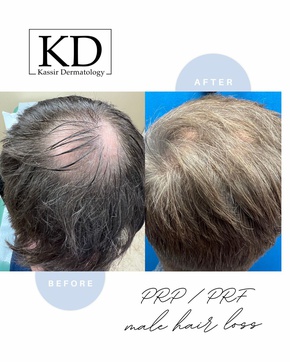
PRP

Hair loss, or alopecia, may present in several ways. It may be partial or complete and occur in any hair-bearing area of the body, although in our clinic we usually see patients present for hair loss of the scalp, eyebrows, and eyelashes.
Request More Info About
PRP
PRP IN DEPTH
by Martin Kassir, M.D., F.A.A.D.
aSKINg the EXPERT: PRP
What is PRP?
PRP is short for Platelet Rich Plasma
PRP is plasma with more platelets than is typically found in blood.
To create platelet-rich plasma, a patient's blood is drawn and placed into a centrifuge that rapidly spins the blood. The platelets are separated from the other components of the blood. The PRP is then injected into the target area (scalp, joints and so forth). The concentration of growth factors is increased in these target areas to enhance healing.
What does PRP do?
PRP has a higher concentration of platelets, and therefore growth factors which can help healing or enhance tissue regeneration. PRP treatment can help support wound healing in trauma and joint injury. PRP can also address androgenetic alopecia (hair loss, male pattern baldness) and stimulate the growth of hair transplants.
Why Are Platelets Important?
Platelets release over 30 bioactive proteins and growth factors that enhance tissue regeneration and healing
Does PRP have any side effects?
Since PRP comes from your own blood, there is an EXTREMELY LOW TO ZERO chance of an allergic reaction. Since there are many injections in the scalp for hair issues, there may be some discomfort. Discomfort can vary from individual to individual. There may be some swelling and bleeding at the injection sites. There may be bruising after injections if used on the face, as with other injectables.
Who is NOT a good candidate for PRP?
Patients with conditions which require BLOOD THINNERS are may or may not be candidates for PRP.
If you have an active infection in the area to be treated, you are NOT a good candidate for PRP until the infection resolves.
What is the PRP success rate for hair loss?
This question is extremely dependent on preselection of the patients, the areas injected, and the injection technique used. The injection technique needs to be individualized for each patient.
How does PRP work?
The mechanism behind PRP injections is not perfectly understood. Studies have shown that increased concentration of growth factors in PRP can potentially stimulate or speed up the healing process and encourage hair growth.
Kassir Dermatology © 2025






